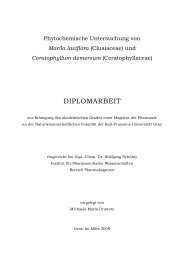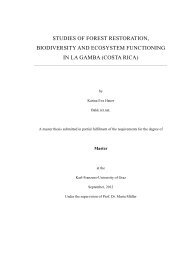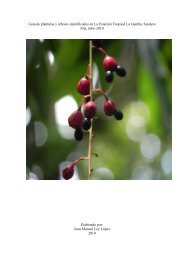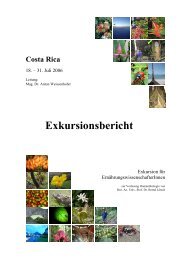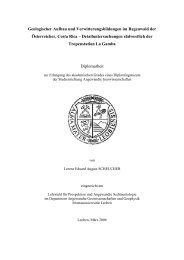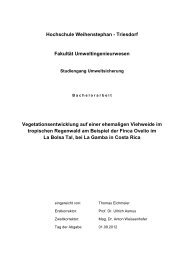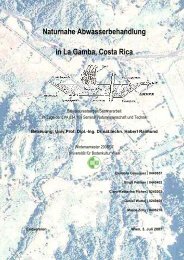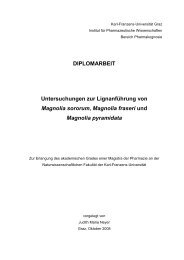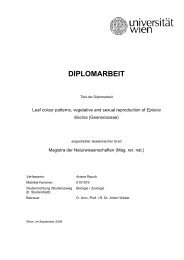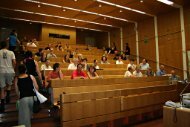Die Tropenstation La Gamba
Die Tropenstation La Gamba
Die Tropenstation La Gamba
Sie wollen auch ein ePaper? Erhöhen Sie die Reichweite Ihrer Titel.
YUMPU macht aus Druck-PDFs automatisch weboptimierte ePaper, die Google liebt.
<strong>Die</strong> „<strong>Tropenstation</strong> <strong>La</strong> <strong>Gamba</strong>“ in Costa Rica – Wissenschaftlicher Bericht<br />
FISCHER, R. C., RICHTER, A., WANEK, W., MAYER, V. 2002. Plants feed ants: Food bodies of<br />
myrmecophytic Piper and their significance for the interaction with Pheidole bicornis ants.<br />
Oecologia (2002) 133: 186-192<br />
Several species of Piper (Piperaceae) live in symbiosis with Pheidole bicornis (Formicidae-<br />
Myrmicinae) on the Southern Pacific slope of Costa Rica. These plants produce small singlecelled<br />
food bodies (FBs) in leaf-domatia, formed by the petiole bases and roofing leaf sheaths. In<br />
the present study the dependency of ants on FBs of Piper fimbriulatum as food source was<br />
analyzed by comparing the natural abundance of 13 C and 15 N in ants and FBs. Both δ 13 C and δ 15 N<br />
values were very similar between FBs and Pheidole bicornis ants but differed substantially<br />
between the plant and other ant species. Therefore we suggest that FBs are a main food source for<br />
Pheidole bicornis ants. To strengthen this suggestion, the chemical composition of FBs of four<br />
myrmecophytic Piper species was analyzed, with special emphasis on the nutritional requirements<br />
of inhabiting Pheidole bicornis ants. Standard chemical methods were modified and combined to<br />
a novel analysis scheme by which all major FB constituents could be quantified from minute (3 to<br />
10 mg dry mass) quantities. Piper FBs mainly consisted of lipids (41% to 48% of dry mass) and<br />
proteins (17% to 24% of dry mass). Soluble carbohydrates and amino acids proved to be<br />
quantitatively unimportant. Nitrogen was predominantly stored as soluble protein and, thus, was<br />
easily available for the ants. FBs proved to be a high-energy food source (up to 23 kJ g -1 DM),<br />
with a chemical composition that meets well the nutritional needs of the inhabiting ants.<br />
Keywords ant-plant mutualism, myrmecophyte, nutrient provisioning, stable isotopes 15 N and 13 C, symbiosis<br />
Anschrift der Autoren:<br />
Mag. Renate Fischer, a8907336@unet.univie.ac.at<br />
Univ. Ass. Mag. Dr. Wolfgang Wanek, wolfgang.wanek@univie.ac.at<br />
Univ. Prod. Dr. Andreas Richter, andreas .richter@univie.ac.at<br />
Univ. Wien, Inst. f. Ökologie und Naturschutz<br />
Althanstraße 3, A-1090 Wien<br />
Tel. ++43 4277-54204<br />
Fax ++42 4277-9542<br />
Univ. Ass. Dr. Veronika Mayer, veronika.mayer@univie.ac.at<br />
Univ. Wien, Inst. f. Botanik, Rennweg 14, A-1030 Wien<br />
Tel. ++43 4277-54083<br />
Fax ++42 4277-9541<br />
63



